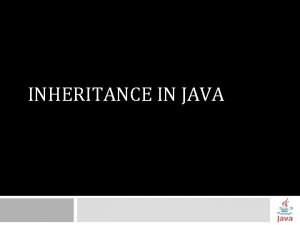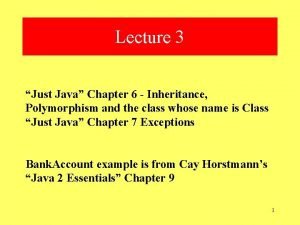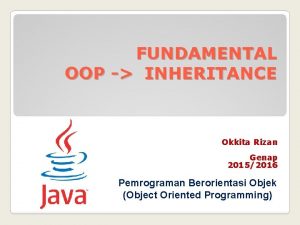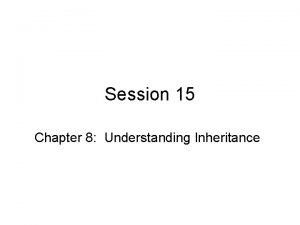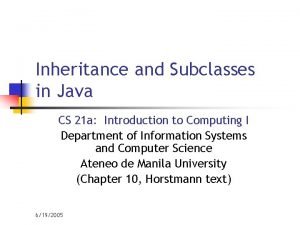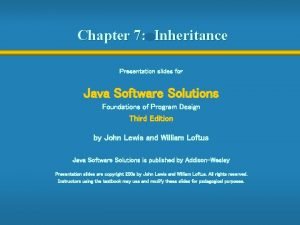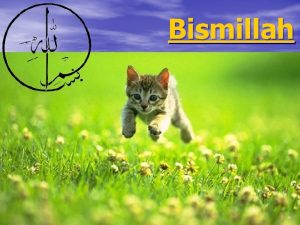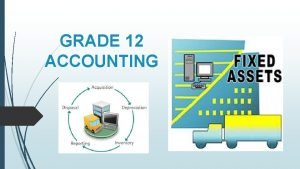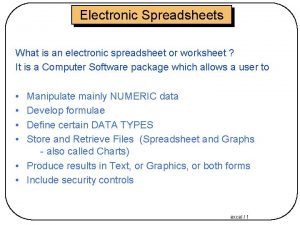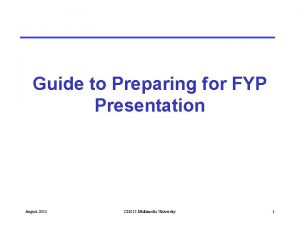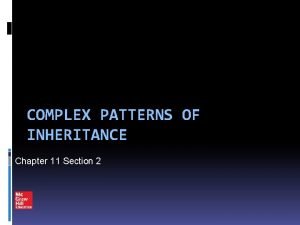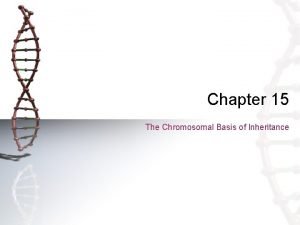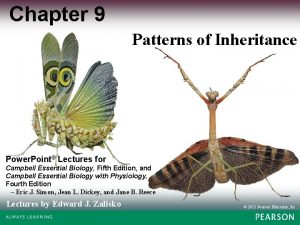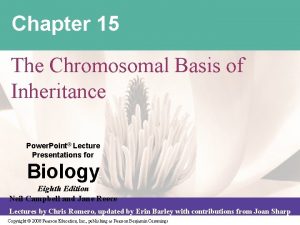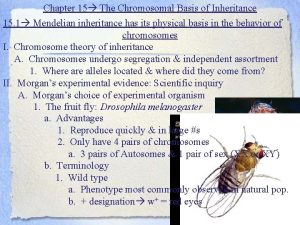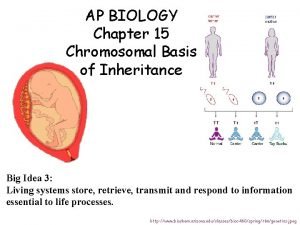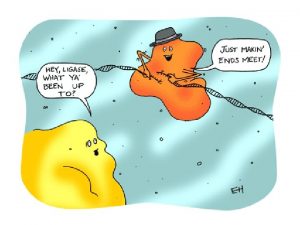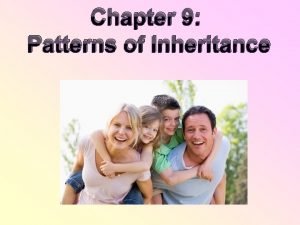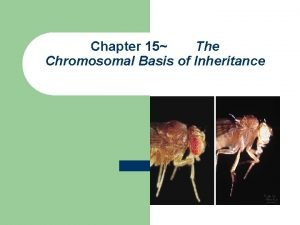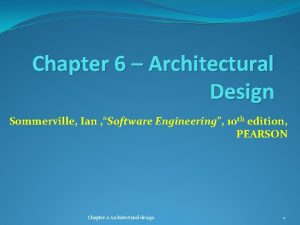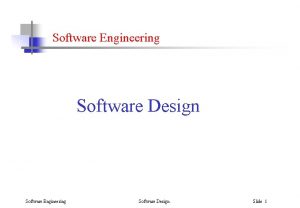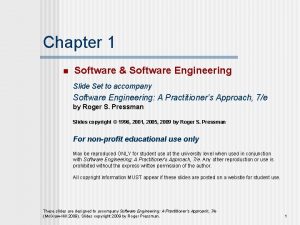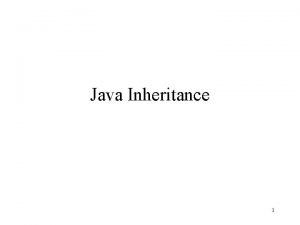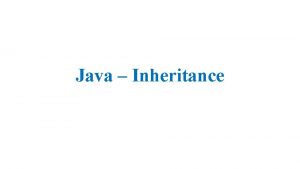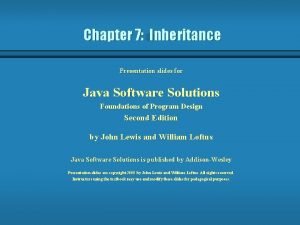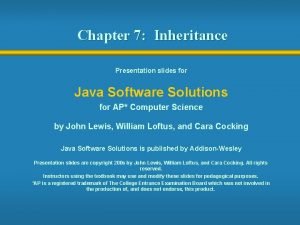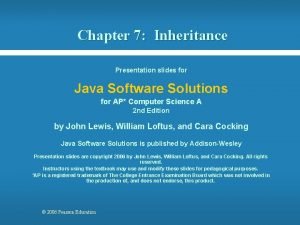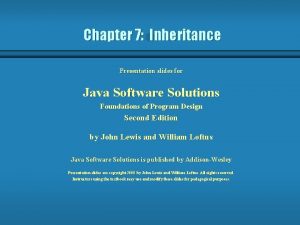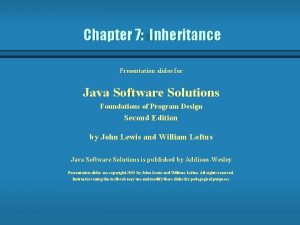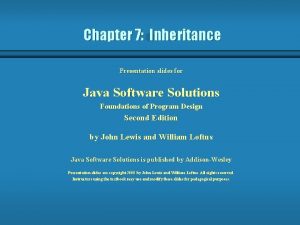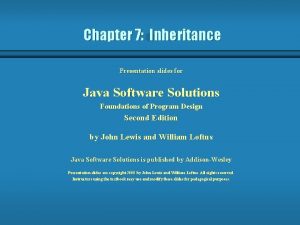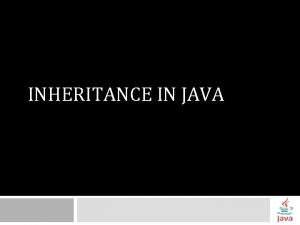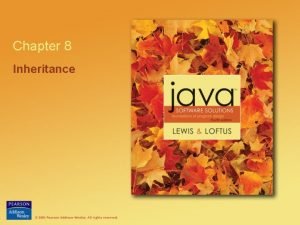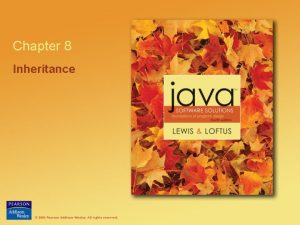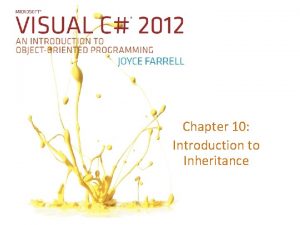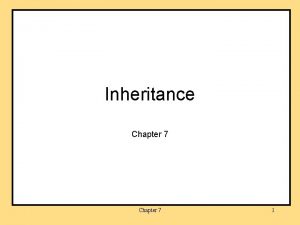Chapter 7 Inheritance Presentation slides for Java Software









































- Slides: 41

Chapter 7: Inheritance Presentation slides for Java Software Solutions for AP* Computer Science by John Lewis, William Loftus, and Cara Cocking Java Software Solutions is published by Addison-Wesley Presentation slides are copyright 200 s by John Lewis, William Loftus, and Cara Cocking. All rights reserved. Instructors using the textbook may use and modify these slides for pedagogical purposes. *AP is a registered trademark of The College Entrance Examination Board which was not involved in the production of, and does not endorse, this product.

Inheritance Ø Another fundamental object-oriented technique is inheritance, used to organize and create reusable classes Ø Chapter 7 focuses on: • • • deriving new classes from existing classes creating class hierarchies abstract classes polymorphism via inheritance used in graphical user interfaces 2

Inheritance Ø Inheritance allows a software developer to derive a new class from an existing one Ø The existing class is called the parent class, or superclass, or base class Ø The derived class is called the child class or subclass. Ø As the name implies, the child inherits characteristics of the parent Ø That is, the child class inherits the methods and data defined for the parent class 3

Inheritance Ø To tailor a derived class, the programmer can add new variables or methods, or can modify the inherited ones Ø Software reuse is at the heart of inheritance Ø By using existing software components to create new ones, we capitalize on all the effort that went into the design, implementation, and testing of the existing software 4

Inheritance Ø Inheritance relationships often are shown graphically in a UML class diagram, with an arrow with an open arrowhead pointing to the parent class Vehicle Car Inheritance should create an is-a relationship, meaning the child is a more specific version of the parent 5

Deriving Subclasses Ø In Java, we use the reserved word extends to establish an inheritance relationship class Car extends Vehicle { // class contents } Ø See Words. java (page 383) Ø See Book. java (page 384) Ø See Dictionary. java (page 385) 6

Visibility Modifiers Ø Visibility modifiers determine which class members are inherited and which are not Ø Variables and methods declared with public visibility are inherited Ø Variables and methods declared with private visibility are not 7

The super Reference Ø Constructors are not inherited, even though they have public visibility Ø Yet we often want to use the parent's constructor to set up the "parent's part" of the object Ø The super reference can be used to refer to the parent class, and often is used to invoke the parent's constructor Ø See Words 2. java (page 387) Ø See Book 2. java (page 388) Ø See Dictionary 2. java (page 389) 8

The super Reference Ø A child’s constructor is responsible for calling the parent’s constructor Ø The first line of a child’s constructor should use the super reference to call the parent’s constructor Ø The super reference can also be used to reference other variables and methods defined in the parent’s class 9

Multiple Inheritance Ø Java supports single inheritance, meaning that a derived class can have only one parent class Ø Multiple inheritance allows a class to be derived from two or more classes, inheriting the members of all parents Ø Collisions, such as the same variable name in two parents, have to be resolved Ø Java does not support multiple inheritance Ø In most cases, the use of interfaces gives us aspects of multiple inheritance without the overhead 10

Overriding Methods Ø A child class can override the definition of an inherited method in favor of its own Ø The new method must have the same signature as the parent's method, but can have a different body Ø The type of the object executing the method determines which version of the method is invoked Ø See Messages. java (page 391) Ø See Thought. java (page 392) Ø See Advice. java (page 393) 11

Overloading vs. Overriding Ø Don't confuse the concepts of overloading and overriding Ø Overloading deals with multiple methods with the same name in the same class, but with different signatures Ø Overriding deals with two methods, one in a parent class and one in a child class, that have the same signature Ø Overloading lets you define a similar operation in different ways for different data Ø Overriding lets you define a similar operation in different ways for different object types 12

Class Hierarchies Ø A child class of one parent can be the parent of another child, forming a class hierarchy Business Retail Business KMart Macys Service. Business Kinkos 13

Class Hierarchies Ø Two children of the same parent are called siblings Ø Common features should be put as high in the hierarchy as is reasonable Ø An inherited member is passed continually down the line Ø Therefore, a child class inherits from all its ancestor classes Ø There is no single class hierarchy that is appropriate for all situations 14

The Object Class Ø A class called Object is defined in the java. lang package of the Java standard class library Ø All classes are derived from the Object class Ø If a class is not explicitly defined to be the child of an existing class, it is assumed to be the child of the Object class Ø Therefore, the Object class is the ultimate root of all class hierarchies 15

The Object Class Ø The Object class contains a few useful methods, which are inherited by all classes Ø For example, the to. String method is defined in the Object class Ø Every time we have defined to. String, we have actually been overriding an existing definition Ø The to. String method in the Object class is defined to return a string that contains the name of the object’s class together along with some other information 16

The Object Class Ø All objects are guaranteed to have a to. String method via inheritance Ø Thus the println method can call to. String for any object that is passed to it Ø See Academia. java (page 396) Ø See Student. java (page 397) Ø See Student. Athlete. java (page 398) 17

The Object Class Ø The equals method of the Object class returns true if two references are aliases Ø We can override equals in any class to define equality in some more appropriate way Ø The String class (as we've seen) defines the equals method to return true if two String objects contain the same characters Ø Therefore the String class has overridden the equals method inherited from Object in favor of its own version 18

Abstract Classes Ø An abstract class is a placeholder in a class hierarchy that represents a generic concept Ø An abstract class cannot be instantiated Ø We use the modifier abstract on the class header to declare a class as abstract: public abstract class Whatever { // contents } 19

Abstract Classes Ø An abstract class often contains abstract methods with no definitions (like an interface does) Ø Unlike an interface, the abstract modifier must be applied to each abstract method Ø An abstract class typically contains non-abstract methods (with bodies), further distinguishing abstract classes from interfaces Ø A class declared as abstract does not need to contain abstract methods 20

Abstract Classes Ø The child of an abstract class must override the abstract methods of the parent, or it too will be considered abstract Ø An abstract method cannot be defined as static (because it has no definition yet) Ø The use of abstract classes is a design decision – it Ø Ø helps us establish common elements in a class that is too general to instantiate See Pets. java (page 401) See Pet. java (page 402) See Dog. java (page 403) See Snake. java (page 404) 21

Indirect Use of Members Ø An inherited member can be referenced directly by name in the child class, as if it were declared in the child class Ø But even if a method or variable is not inherited by a child, it can still be accessed indirectly through parent methods Ø See Food. Analysis. java (page 406) Ø See Food. Item. java (page 407) Ø See Pizza. java (page 408) 22

Polymorphism Ø A reference can be polymorphic, which can be defined as "having many forms" obj. do. It(); Ø This line of code might execute different methods at different times if the object that obj points to changes Ø Polymorphic references are resolved at run time; this is called dynamic binding Ø Careful use of polymorphic references can lead to elegant, robust software designs Ø Polymorphism can be accomplished using inheritance or using interfaces 23

References and Inheritance Ø An object reference can refer to an object of its class, or to an object of any class related to it by inheritance Ø For example, if the Holiday class is used to derive a child class called Christmas, then a Holiday reference could be used to point to a Christmas object Holiday day; day = new Christmas(); Christmas 24

References and Inheritance Ø Assigning a predecessor object to an ancestor reference is considered to be a widening conversion, and can be performed by simple assignment Ø Assigning an ancestor object to a predecessor reference can be done also, but it is considered to be a narrowing conversion and must be done with a cast Ø The widening conversion is the most useful Ø An Object reference can be used to refer to any object • An Array. List is designed to hold Object references 25

Polymorphism via Inheritance Ø It is the type of the object being referenced, not the reference type, that determines which method is invoked Ø Suppose the Holiday class has a method called celebrate, and the Christmas class overrides it Ø Now consider the following invocation: day. celebrate(); Ø If day refers to a Holiday object, it invokes the Holiday version of celebrate; if it refers to a Christmas object, it invokes the Christmas version 26

Polymorphism via Inheritance Ø Consider the following class hierarchy: Staff. Member Volunteer Employee Executive Hourly 27

Polymorphism via Inheritance Ø Now consider the task of paying all employees Ø See Firm. java (page 412) Ø See Staff. java (page 414) Ø See Staff. Member. java (page 416) Ø See Volunteer. java (page 417) Ø See Employee. java (page 418) Ø See Executive. java (page 420) Ø See Hourly. java (page 421) 28

Polymorphism via Interfaces Ø An interface name can be used as the type of an object reference variable Doable obj; Ø The obj reference can be used to point to any object of any class that implements the Doable interface Ø The version of do. This that the following line invokes depends on the type of object that obj is referencing obj. do. This(); 29

Inheritance and GUIs Ø An applet is an excellent example of inheritance Ø Recall that when we define an applet, we extend the Applet class or the JApplet class Ø The Applet and JApplet classes already handle all the details about applet creation and execution, including: • interaction with a Web browser • accepting applet parameters through HTML • enforcing security restrictions 30

Inheritance and GUIs Ø Our applet classes only have to deal with issues that specifically relate to what our particular applet will do Ø When we define the paint method of an applet, for instance, we are actually overriding a method defined in the Component class, which is ultimately inherited into the Applet or JApplet class 31

The Component Class Hierarchy Ø The Java classes that define GUI components are part of a class hierarchy Ø Swing GUI components typically are derived from the JComponent class which is derived from the Container class which is derived from the Component class Ø Many Swing components can serve as (limited) containers, because they are derived from the Container class 32

Mouse Events Ø Events related to the mouse are separated into mouse events and mouse motion events Ø Mouse Events: • mouse pressed – the mouse button is pressed down • mouse released – the mouse button is released • mouse clicked – the mouse button is pressed down and released without moving the mouse in between • mouse entered – the mouse pointer is moved onto (over) a component • mouse exited – the mouse pointer is moved off of a component 33

Mouse Events Ø Mouse Motion Events: • mouse moved – the mouse is moved • mouse dragged – the mouse is dragged Ø To satisfy the implementation of a listener interface, empty methods must be provided for unused events Ø An Array. List object is used to store objects so they can be redrawn as necessary Ø See Dots. java (page 432) Ø See Dots. Panel. java (page 433) 34

The Dots Program 35

Mouse Events Ø Each time the repaint method is called on an applet, the window is cleared prior to calling paint Ø Rubberbanding is the visual effect caused by "stretching" a shape as it is drawn using the mouse Ø See Rubber. Lines. java (page 436) Ø See Rubber. Lines. Panel. java (page 437) 36

The Rubber. Lines Program 37

Event Adapter Classes Ø Listener classes can be created by implementing a particular interface (such as Mouse. Listener interface) Ø A listener also can be created by extending an event adapter class Ø Each listener interface has a corresponding adapter class (such as the Mouse. Adapter class) Ø Each adapter class implements the corresponding listener and provides empty method definitions 38

Event Adapter Classes Ø When we derive a listener class from an adapter class, we override any event methods of interest (such as the mouse. Clicked method) Ø Empty definitions for unused event methods need not be provided Ø See Off. Center. java (page 440) Ø See Off. Center. Panel. java (page 441) 39

The Off. Center Program 40

Summary Ø Chapter 7 has focused on: • • • deriving new classes from existing classes creating class hierarchies abstract classes polymorphism via inheritance used in graphical user interfaces 41
 A small child slides down the four frictionless slides
A small child slides down the four frictionless slides Each of the boxes shown is pulled for 10 m
Each of the boxes shown is pulled for 10 m Java inheritance
Java inheritance Advantages of inheritance
Advantages of inheritance Savings account java
Savings account java Inheritance in java
Inheritance in java Contoh program inheritance java
Contoh program inheritance java Java inheritance lab exercise
Java inheritance lab exercise Define inheritence
Define inheritence Inheritance presentation
Inheritance presentation Bru slogan
Bru slogan Bismillah in the name of allah
Bismillah in the name of allah Final year project presentation template
Final year project presentation template 1.fyp
1.fyp Conclusion for cloud computing presentation
Conclusion for cloud computing presentation Grade 12 fixed asset note
Grade 12 fixed asset note What is the electronic spreadsheet
What is the electronic spreadsheet Final year project presentation template
Final year project presentation template Thank you images for presentation slides
Thank you images for presentation slides Scientific presentation structure
Scientific presentation structure Fyp presentation slides example
Fyp presentation slides example Alteryx presentation slides
Alteryx presentation slides Klasifikasi jembatan menurut letak lantai jembatan
Klasifikasi jembatan menurut letak lantai jembatan Chapter 11 section 2: complex patterns of inheritance
Chapter 11 section 2: complex patterns of inheritance Chapter 16 the molecular basis of inheritance
Chapter 16 the molecular basis of inheritance Chromosomal theory of inheritance
Chromosomal theory of inheritance Chapter 11 complex inheritance and human heredity test
Chapter 11 complex inheritance and human heredity test A gene locus is
A gene locus is The molecular basis of inheritance chapter 16
The molecular basis of inheritance chapter 16 Chapter 15 the chromosomal basis of inheritance
Chapter 15 the chromosomal basis of inheritance The chromosomal basis of inheritance chapter 15
The chromosomal basis of inheritance chapter 15 Ap biology chapter 15
Ap biology chapter 15 Chapter 11 section 1 basic patterns of human inheritance
Chapter 11 section 1 basic patterns of human inheritance Chapter 11 section 1 basic patterns of human inheritance
Chapter 11 section 1 basic patterns of human inheritance Chapter 13 the molecular basis of inheritance
Chapter 13 the molecular basis of inheritance Chapter 9 patterns of inheritance
Chapter 9 patterns of inheritance Chapter 15: the chromosomal basis of inheritance
Chapter 15: the chromosomal basis of inheritance Sommerville software engineering slides
Sommerville software engineering slides Cohesion in software engineering
Cohesion in software engineering Software engineering slides
Software engineering slides Iso 22301 utbildning
Iso 22301 utbildning Typiska novell drag
Typiska novell drag


